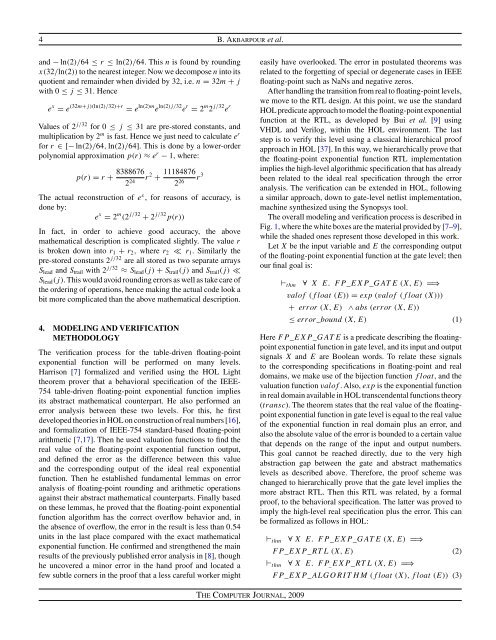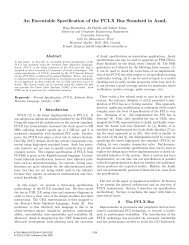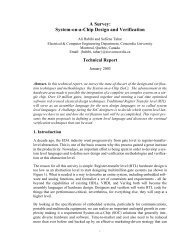Verifying a Synthesized Implementation of IEEE-754 Floating-Point ...
Verifying a Synthesized Implementation of IEEE-754 Floating-Point ...
Verifying a Synthesized Implementation of IEEE-754 Floating-Point ...
- No tags were found...
You also want an ePaper? Increase the reach of your titles
YUMPU automatically turns print PDFs into web optimized ePapers that Google loves.
4 B. Akbarpour et al.and − ln(2)/64 ≤ r ≤ ln(2)/64. This n is found by roundingx(32/ln(2)) to the nearest integer. Now we decompose n into itsquotient and remainder when divided by 32, i.e. n = 32m + jwith 0 ≤ j ≤ 31. Hencee x = e (32m+j)(ln(2)/32)+r = e ln(2)m e ln(2)j/32 e r = 2 m 2 j/32 e rValues <strong>of</strong> 2 j/32 for 0 ≤ j ≤ 31 are pre-stored constants, andmultiplication by 2 m is fast. Hence we just need to calculate e rfor r ∈[−ln(2)/64, ln(2)/64]. This is done by a lower-orderpolynomial approximation p(r) ≈ e r − 1, where:p(r) = r + 83886762 24 r 2 + 111848762 26 r 3The actual reconstruction <strong>of</strong> e x , for reasons <strong>of</strong> accuracy, isdone by:e x = 2 m (2 j/32 + 2 j/32 p(r))In fact, in order to achieve good accuracy, the abovemathematical description is complicated slightly. The value ris broken down into r 1 + r 2 , where r 2 ≪ r 1 . Similarly thepre-stored constants 2 j/32 are all stored as two separate arraysS lead and S trail with 2 j/32 ≈ S lead (j) + S trail (j) and S trail (j) ≪S lead (j). This would avoid rounding errors as well as take care <strong>of</strong>the ordering <strong>of</strong> operations, hence making the actual code look abit more complicated than the above mathematical description.4. MODELING AND VERIFICATIONMETHODOLOGYThe verification process for the table-driven floating-pointexponential function will be performed on many levels.Harrison [7] formalized and verified using the HOL Lighttheorem prover that a behavioral specification <strong>of</strong> the <strong>IEEE</strong>-<strong>754</strong> table-driven floating-point exponential function impliesits abstract mathematical counterpart. He also performed anerror analysis between these two levels. For this, he firstdeveloped theories in HOL on construction <strong>of</strong> real numbers [16],and formalization <strong>of</strong> <strong>IEEE</strong>-<strong>754</strong> standard-based floating-pointarithmetic [7,17]. Then he used valuation functions to find thereal value <strong>of</strong> the floating-point exponential function output,and defined the error as the difference between this valueand the corresponding output <strong>of</strong> the ideal real exponentialfunction. Then he established fundamental lemmas on erroranalysis <strong>of</strong> floating-point rounding and arithmetic operationsagainst their abstract mathematical counterparts. Finally basedon these lemmas, he proved that the floating-point exponentialfunction algorithm has the correct overflow behavior and, inthe absence <strong>of</strong> overflow, the error in the result is less than 0.54units in the last place compared with the exact mathematicalexponential function. He confirmed and strengthened the mainresults <strong>of</strong> the previously published error analysis in [8], thoughhe uncovered a minor error in the hand pro<strong>of</strong> and located afew subtle corners in the pro<strong>of</strong> that a less careful worker mighteasily have overlooked. The error in postulated theorems wasrelated to the forgetting <strong>of</strong> special or degenerate cases in <strong>IEEE</strong>floating-point such as NaNs and negative zeros.After handling the transition from real to floating-point levels,we move to the RTL design. At this point, we use the standardHOL predicate approach to model the floating-point exponentialfunction at the RTL, as developed by Bui et al. [9] usingVHDL and Verilog, within the HOL environment. The laststep is to verify this level using a classical hierarchical pro<strong>of</strong>approach in HOL [37]. In this way, we hierarchically prove thatthe floating-point exponential function RTL implementationimplies the high-level algorithmic specification that has alreadybeen related to the ideal real specification through the erroranalysis. The verification can be extended in HOL, followinga similar approach, down to gate-level netlist implementation,machine synthesized using the Synopsys tool.The overall modeling and verification process is described inFig. 1, where the white boxes are the material provided by [7–9],while the shaded ones represent those developed in this work.Let X be the input variable and E the corresponding output<strong>of</strong> the floating-point exponential function at the gate level; thenour final goal is:⊢ thm ∀ X E. FP_EXP_GAT E (X, E) =⇒val<strong>of</strong> (float (E)) = exp (val<strong>of</strong> (f loat (X)))+ error (X,E) ∧ abs (error (X,E))≤ error_bound (X, E) (1)Here FP_EXP_GAT E is a predicate describing the floatingpointexponential function in gate level, and its input and outputsignals X and E are Boolean words. To relate these signalsto the corresponding specifications in floating-point and realdomains, we make use <strong>of</strong> the bijection function float, and thevaluation function val<strong>of</strong> . Also, exp is the exponential functionin real domain available in HOL transcendental functions theory(transc). The theorem states that the real value <strong>of</strong> the floatingpointexponential function in gate level is equal to the real value<strong>of</strong> the exponential function in real domain plus an error, andalso the absolute value <strong>of</strong> the error is bounded to a certain valuethat depends on the range <strong>of</strong> the input and output numbers.This goal cannot be reached directly, due to the very highabstraction gap between the gate and abstract mathematicslevels as described above. Therefore, the pro<strong>of</strong> scheme waschanged to hierarchically prove that the gate level implies themore abstract RTL. Then this RTL was related, by a formalpro<strong>of</strong>, to the behavioral specification. The latter was proved toimply the high-level real specification plus the error. This canbe formalized as follows in HOL:⊢ thm ∀ X E. FP_EXP_GAT E (X, E) =⇒FP_EXP_RT L (X, E) (2)⊢ thm ∀ X E. FP _ EXP_RT L (X, E) =⇒FP_EXP_ALGORIT H M (f loat (X), f loat (E)) (3)The Computer Journal, 2009





